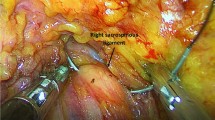Abstract
The objective of this study was to evaluate our technique and steps of robotic and laparoendoscopic single-site utero-sacral ligament suspension in the treatment of patients with symptomatic apical vaginal prolapse. A retrospective analysis was done using the data in 2 community hospital. Eighteen women presented with vaginal apex prolapse and desired minimally invasive surgery (video): (a) Laparoendoscopic single-site utero-sacral ligament suspension (LESS-UTSLS) (n = 13) or (b) robotic-assisted single-site utero-sacral ligament suspension (RASS-UTSLS) (n = 5) were eligible to participate. All participants underwent a standardized evaluation, including a structured urogynecologic history and physical examination with pelvic organ prolapse quantitative stage. Participants also completed validated questionnaire about pain scale. Multiples perioperative values were obtained to evaluate our minimally invasive approach. There were no differences in demographic, pre-operative anatomic, and functional data between groups. Concomitant anti-incontinence surgery with trans-obturator tape among the LESS-UTSLS vs RASS-UTSLS groups was performed in 2 (15 %) compared with 0 (0 %) and vaginal hysterectomy 2 (15 %) compared with supracervical hysterectomy 2 (40 %), respectively. The UTSLS operating time was similar in the RASS group compared with the LESS group (difference 9 min. There were only one POP (8 %) recurrence (stage 3) and one umbilical hernia (8 %) in the LESS-UTSLS group after 12 months of surgery. Two patients (15 %) developed stress urinary incontinence after LESS-UTSLS. We presented our technique and perioperative outcomes. RASS-UTSLS was similar operative times to LESS UTSL (+9 min), no differences in post-operative pain, anatomic support, or complications 6 months. We found that robotic surgical systems may accelerate the learning curve in the single-site surgery. Future investigations are warranted to discern the best applications for robotic single site technology in benign gynecologic surgery.

Similar content being viewed by others
References
Hendrix SL, Clark A, Nygaard I, Aragaki A, Barnabei V, McTiernan A (2002) Pelvic organ prolapse in the women’s health initiative: gravity and gravidity. Am J Obstet Gynecol 186(6):1160–1166
Webb MJ, Aronson MP, Ferguson LK, Lee RA (1998) Posthysterectomy vaginal vault prolapse: primary repair in 693 patients. Obstet Gynecol 92:281–285
Sze EH, Karram MM (1997) Transvaginal repair of vault prolapse: a review. Obstet Gynecol 89:466–475
Silva WA, Pauls RN, Segal JL, Rooney CM, Kleeman SD, Karram MM (2006) Uterosacral ligament vault suspension five-year outcomes. Obstet Gynecol 108(2):255–263
Olsen AL, Smith VJ, Bergstrom JO, Colling JC, Clark AL (1997) Epidemiology of surgically managed pelvic organ prolapse and urinary incontinence. Obstet Gynecol 89:501–506
Subak LL, Waetjen LE, van den Eeden S, Thom DH, Vittinghoff E, Brown JS (2001) Cost of pelvic organ prolapse surgery in the United States. Obstet Gynecol 98:646–651
Nygaard IE, McCreery R, Brubaker L, Connolly AM, Cundiff G, Weber AM et al (2004) Abdominal sacrocolpopexy: a comprehensive review. Obstet Gynecol 104:805–823
Cosson M, Rajabally R, Bogaert E, Querleu D, Crepin G (2002) Laparoscopic sacrocolpopexy, hysterectomy, and burch colposuspension: feasibility and short-term complications of 77 procedures. JSLS 6:115–119
Nezhat CH, Nezhat F, Nezhat C (1994) Laparoscopic sacral colpopexy for vaginal vault prolapse. Obstet Gynecol 84:885–888
Ostrzenski A (1996) Laparoscopic colposuspension for total vaginal prolapse. Int J Gynaecol Obstet 55:147–152
Paraiso MFR, Jelovsek JE, Frick A, Chen CCG, Barber MD (2011) Laparoscopic compared with robotic sacrocolpopexy for vaginal prolapse. A randomized controlled trial. Obstet Gynecol 118:1005–1013
Paraiso MF, Walters MD, Rackley RR, Melek S, Hugney C (2005) Laparoscopic and abdominal sacral colpopexies: a comparative cohort study. Am J Obstet Gynecol 192:1752–1758
Klauschie JL, Suozzi BA, O’Brien MM, McBride AW (2009) A comparison of laparoscopic and abdominal sacral colpopexy: objective outcome and perioperative differences. Int Urogynecol J Pelvic Floor Dysfunct 20:273–279
Hsiao KC, Latchamsetty K, Govier FE, Kozlowski P, Kobashi KC (2007) Comparison of laparoscopic and abdominal sacrocolpopexy for the treatment of vaginal vault prolapse. J Endourol 21:926–930
Geller EJ, Siddiqui NY, Wu JM, Visco AG (2008) Short-term outcomes of robotic sacrocolpopexy compared with abdominal sacrocolpopexy. Obstet Gynecol 112:1201–1206
McCarthy M Jr, Jonasson O, Chang CH, Pickard AS, Giobbie-Hurder A, Gibbs J et al (2005) Assessment of patient functional status after surgery. J Am Coll Surg 201:171–178
Yohannes P, Rotariu P, Pinto P, Smith AD, Lee BR (2002) Comparison of robotic versus laparoscopic skills: is there a difference in the learning curve? Urology 60:39–45 (discussion 45)
Chandra V, Nehra D, Parent R, Woo R, Reyes R, Hernandez-Boussard T et al (2010) A comparison of laparoscopic and robotic assisted suturing performance by experts and novices. Surgery 147:830–839
Tracy CR, Raman JD, Cadeddu JA, Rane A (2008) Laparoendoscopic single-site surgery in urology: where have we been and where are we heading? Nat Clin Pract Urol 5(10):561–568
Lopez S, Mulla ZD, Hernandez L, Garza DM, Payne TN, Farnam RW (2016) A comparison of outcomes between robotic-assisted, single-site laparoscopy versus laparoendoscopic single site for benign hysterectomy. J Minim Invasive Gynecol 23(1):84–88
Lopez S, Mulla ZD, Hernandez L, Garza DM, Payne TN, Farnam RW (2016) Robotic single-site hysterectomy: feasibility, learning curve and surgical outcome. Surg Endosc 27(7):2638–2643
Brandao LF, Laydner H, Zargar H, Torricelli F, Andreoni C, Kaouk J, Autorino R (2015) Laparoendoscopic single site surgery versus conventional laparoscopy for transperitoneal pyeloplasty: a systematic review and meta-analysis. Urol Ann 7(3):289–296
Author information
Authors and Affiliations
Corresponding author
Ethics declarations
Funding
None.
Conflict of interest
Hugo H. Davila, Taryn Gallo, Lindsey Bruce, and Christopher Landrey declare no conflict of interest.
Ethical approval
All procedures performed in studies involving human participants were in accordance with the ethical standards of the institutional and/or national research committee and with the 1964 Helsinki declaration and its later amendments or comparable ethical standards.
Informed consent
Informed consent was obtained from all individual participants included in the study.
Electronic supplementary material
Below is the link to the electronic supplementary material.
Supplementary material 1 (MP4 343893 kb)
Rights and permissions
About this article
Cite this article
Davila, H.H., Gallo, T., Bruce, L. et al. Robotic and laparoendoscopic single-site utero-sacral ligament suspension for apical vaginal prolapse: evaluation of our technique and perioperative outcomes. J Robotic Surg 11, 171–177 (2017). https://doi.org/10.1007/s11701-016-0638-0
Received:
Accepted:
Published:
Issue Date:
DOI: https://doi.org/10.1007/s11701-016-0638-0



